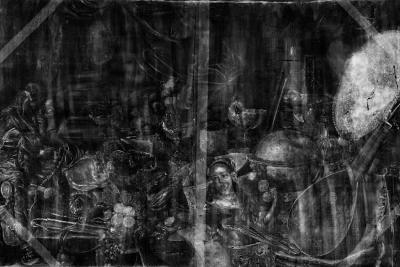Scientific analysis

During conservation, 'The Paston Treasure' was analysed using a variety of scientific techniques, which have revealed alterations made to the composition during painting and changes to the coloured pigments over time.
The presence of mercury in the paint suggests that the lobster would once have been much brighter red but has bleached over time, making it now appear pink. The black smoke from the extinguished candle - painted using carbon - originally would have been more prominent, wafting up into the air to symbolise the passing of time and frailty of human life.
A Xradiograph taken by the Hamilton Kerr Institute clearly reveals changes the artist made to the upper right-hand-side of the painting. A large blue and white dish, similar to the one behind the girl, was once in the space now occupied by the clock. The presence of the blue pigment smalt suggests that the edge of the platter had a blue design. The dish was shortly after over-painted with the three-quarters figure of a woman. Analysis of the underlying pigments reveals that she was wearing a red laced dress with a green or blue sash and had blue ribbons or feathers in her hair. It is likely that she is Lady Margaret Paston (d.1669), William Paston's second wife, whom he married in 1640.
At the end of his life, William Paston was not on good terms with his son Robert and left many of the family treasures instead to Margaret. We do not know why her portrait or the dish were painted out. Perhaps Robert decided to have his step-mother deleted from the painting and replaced with the clock after his father died.

Dr Paola Ricciardi from the Fitzwilliam Museum, University of Cambridge, presents a lecture about what is revealed by scientific analysis of 'The Paston Treasure':
Videos and further reading
Watch lectures and discussions about 'The Paston Treasure', including 'The Paston Treasure: Microcosm of the Known World', from the Yale Center for British Art conference in 2018.


